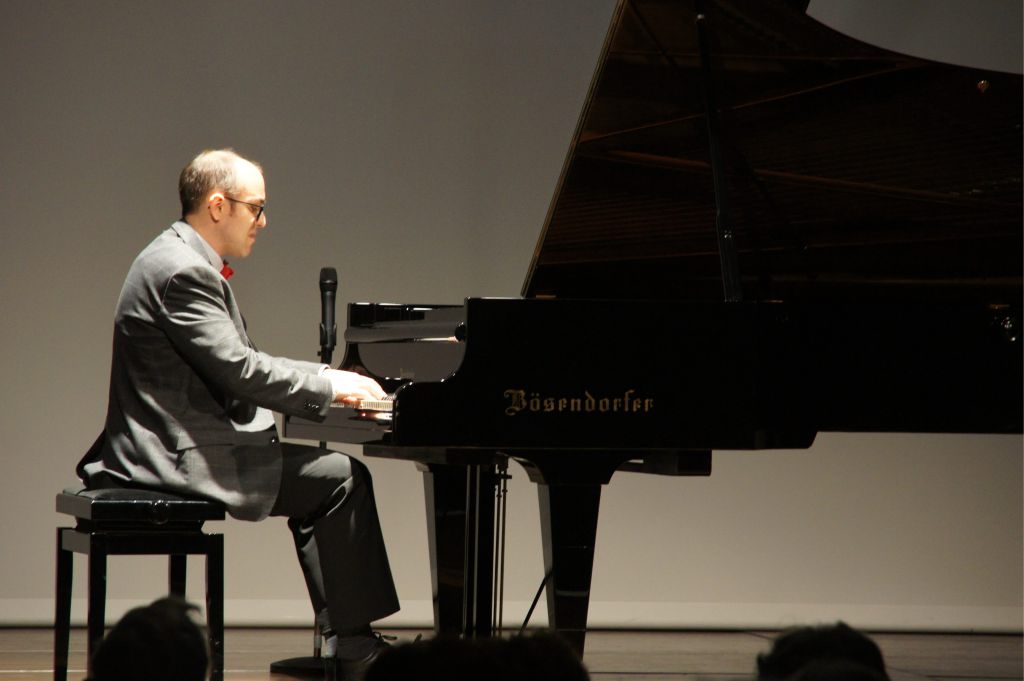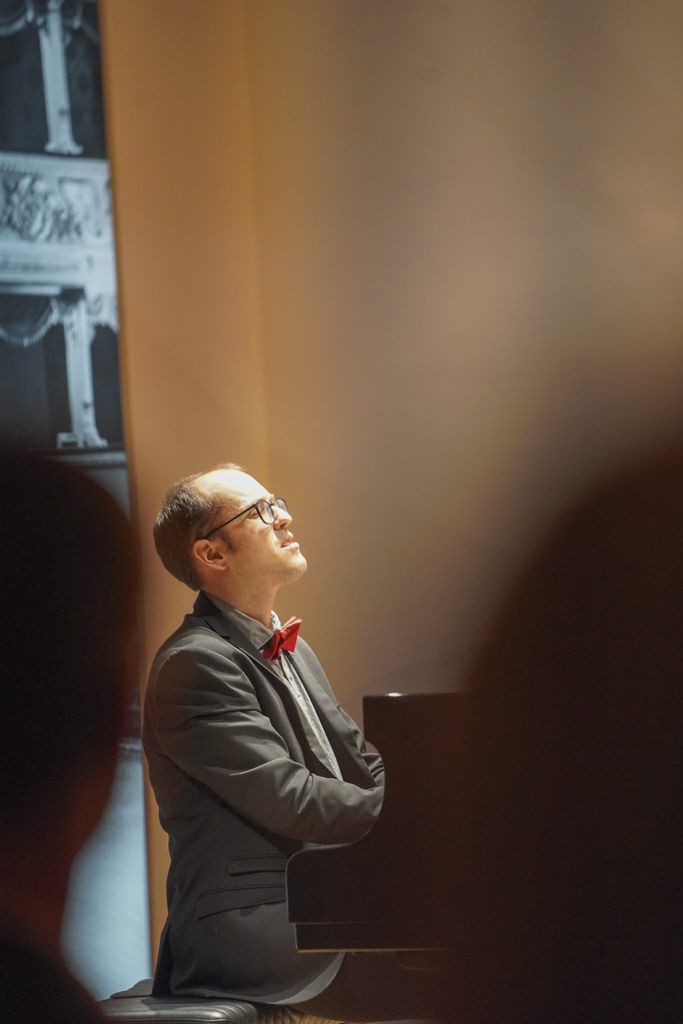Der mdw-Absolvent startet bereits mit sieben Jahren seine Karriere als Pianist. Als Jugendlicher bemerkt er erste Schwierigkeiten in der Motorik seiner linken Hand. Mit 32 Jahren erhält er schließlich die Diagnose „fokale Dystonie“.
Gerade wenn ein Problem auftaucht, übt man ja noch mehr, um es zu beseitigen. Das verstärkt die Symptome der fokalen Dystonie allerdings nur noch mehr.

Andreas Eggertsberger ist das, was man gemeinhin ein Wunderkind nennt. Mit sieben Jahren beschließt er, nachdem er im Musikunterricht der Volksschule das erste Mal Mozart hörte, Klavier zu lernen. Bereits ein halbes Jahr später beherrscht er den Wilden Reiter von Robert Schumann. Er gewinnt aus dem Stand weg den 1. Preis des bundesweiten Wettbewerbs Jugend musiziert und erarbeitet mit neun Jahren im Vorbereitungslehrgang der Anton Bruckner Privatuniversität Ludwig van Beethovens Klaviersonate Pathétique. Mit zwölf Jahren beginnt er das Konzertfachstudium Klavier in Linz, das er mit fünfzehn Jahren als jüngster Absolvent in der Geschichte der Privatuniversität mit Auszeichnung abschließt. Kurze Zeit später beginnt sich jedoch das Blatt des talentierten Musikers zu wenden. Andreas Eggertsberger bemerkt erste Schwierigkeiten in der Motorik seiner linken Hand, denen er jedoch zu Beginn keine große Beachtung schenkt. „Ich habe mir gedacht, ich müsste nur mehr üben, denn wenn da wirklich ein Problem wäre, hätte man das ja im Unterricht bemerkt.“ Er setzt seine Studien am Mozarteum in Salzburg und anschließend an der mdw fort. Entdeckt wurde die Bewegungsstörung schließlich von einer Geigenkollegin während eines Festivals in Italien. Sie macht Andreas Eggertsberger darauf aufmerksam, dass sich seine linke Hand anders bewegt als die rechte – der zweite Finger streckt sich, der dritte rollt sich ein – dadurch werden immer wieder Töne „verschluckt“. Er wendet sich an die Klavierprofessor_innen des Festivals, wird jedoch beruhigt, dass es sich lediglich um seine Art der Körperhaltung handelt. „Ich hatte selber immer mehr den Verdacht, dass etwas nicht stimmt, aber meine Lehrenden haben mich vom Gegenteil überzeugt.“ Auf die Versuche hin, selbst etwas zu ändern, verstärken sich die Symptome. „Ich war völlig ratlos. Schließlich habe ich zu recherchieren begonnen.“ Über den berühmten Pianisten Leon Fleisher, der ebenfalls Probleme mit seiner Hand hatte, findet Eggertsberger heraus, dass es sich um die neurologische Erkrankung fokale Dystonie handeln könnte. Laut Österreichischer Ärztezeitung (Nr. 10, 25. 5. 2013) werden unter dem Begriff Dystonie Bewegungsstörungen mit länger anhaltenden und unwillkürlichen Kontraktionen der Muskulatur zusammengefasst. Die häufigste Form ist die fokale Dystonie. Mehrere Tests beim Neurologen bestätigen schließlich die Annahme. Eggertsberger wird an Dr. Eckart Altenmüller, Professor für Musikphysiologie und Musikermedizin und Leiter der Musiker-Ambulanz an der Hochschule für Musik, Theater und Medien Hannover verwiesen, der ihn darüber informiert, dass man der Dystonie mit Retraining entgegenwirken kann. Zwischen dem Auftauchen der Symptome als Jugendlicher und der Diagnose liegen mittlerweile sechszehn Jahre – mit Höhen und Tiefen. „Einmal war ich der Hochbegabte und dann gab es wieder Stücke, wo ich nicht entsprochen habe. In solchen Momenten fragt man sich, ob es vielleicht ein Fehler war, als hochbegabt eingestuft worden zu sein. Die Diagnose brachte mir schließlich Klarheit und auch Erleichterung.“ Andreas Eggertsberger befindet sich im künstlerischen Doktoratsstudium an der University of Michigan, als die Dystonie diagnostiziert wird. Er informiert seinen Professor, wird jedoch dazu angehalten, weiter an seinen Dissertationskonzerten zu üben. Als es ihm schlussendlich nicht einmal mehr gelingt, den Abstand zwischen den Tasten zu spüren, bricht er den Unterricht ab. Schließlich verkrampft sich seine linke Hand und lässt sich nicht mehr öffnen. Einfachste Bewegungen im Alltag, wie das Binden der Schuhe, können nicht mehr bewältigt werden. Er entschließt sich, wie von Dr. Altenmüller empfohlen, mit dem Retraining bei Laurent Boullet in Berlin zu beginnen. Bereits in der ersten Sitzung wird festgestellt, dass die Finger eine Instabilität der Hand kompensieren. Mit physiotherapeutischen Übungen gelingt es ihm schließlich, seine Dissertationskonzerte zu spielen und das Doktorat abzuschließen. „Über zwei Jahre hinweg habe ich Boullet alle zwei bis vier Monate besucht. Meine Hand wurde immer wieder analysiert und ich habe verschiedene Übungen gelernt.“ Durch das Retraining hat Andreas Eggertsberger sein eigenes Übeverhalten angepasst. Im Fokus stehen nun die Effizienz der Bewegung, die Körperhaltung und die Tonerzeugung ohne große Kraftaufwendung. Das Klavierspiel wird für ihn dadurch weniger anstrengend und verschafft ihm Sicherheit in der Konzertsituation.
Nach zwei Jahren Physiotherapie war ich auf einem guten Weg und habe sogar selbst Ideen für Übungen entwickelt.

Fünf Jahre nach der Diagnose kehrt der Linzer Pianist erfolgreich ans Konzertpodium zurück, 2023 gibt er unter anderem sein Debüt im Rudolfinum in Prag. Heute möchte der engagierte Pianist Bewusstsein für die Erkrankung schaffen, sieht er doch sein enormes Übepensum, gepaart mit einer für ihn unpassenden Technik als Trigger seiner Dystonie. „Ich habe im Sommer mitunter zehn bis elf Stunden am Instrument verbracht. Empfohlen wären vier bis fünf Stunden. Zu dieser extremen Belastung kommt dann noch die Fehlhaltung.“ Gerade in frühen Stadien kann die Pädagogik ansetzen und frühzeitig intervenieren, berichtet die Österreichische Dystonie Gesellschaft (dystonie.at). „Oft sieht man, dass sich Schüler_innen unnatürlich bewegen und verspannt sind – aber das Ergebnis stimmt. Die Verführung ist dann groß, weiterzumachen wie bisher, weil es ja funktioniert. Jedoch wird nicht bedacht, wie es in zwanzig Jahren aussieht“, erklärt Andreas Eggertsberger. Gerade deswegen ist es für den engagierten Musiker so wichtig seine Geschichte zu erzählen und auf die neurologische Bewegungsstörung aufmerksam zu machen, sei es über Blogbeiträge, Vorträge oder seine 2019 veröffentlichte Debüt-CD Dystonia. Angehenden Pianist_innen ein Fundament für eine gesunde Technik zu legen, ist ihm dabei besonders wichtig. „Ich empfehle das Buch Fit 4 Piano von Rae de Lisle. In ihrem Buch beschreibt die Pianistin, wie Kinder spielerisch ein verletzungsvermeidendes Klavierspiel lernen.“
Es ist wichtig, dass Lehrende ihre Schüler_innen genau beobachten und zu einem in Bezug auf Bewegungsstörungen kompetenten Arzt schicken, wenn ihnen etwas Ungewöhnliches auffällt.

